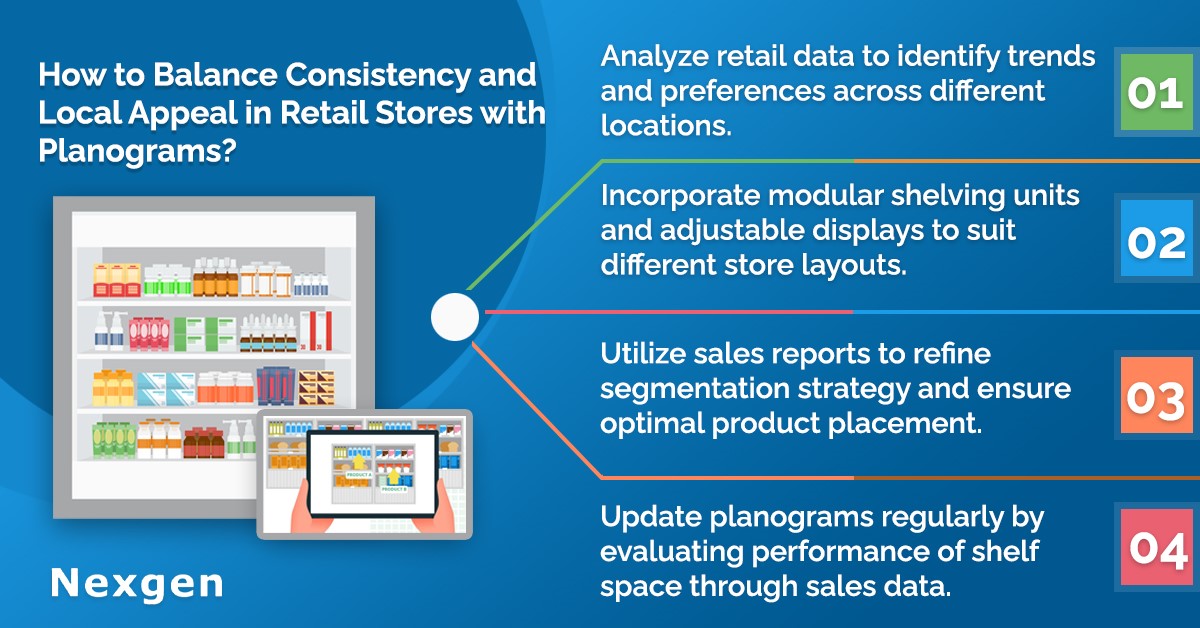Strategic shelf layouts are important to any retail store because they help with customer shopping and brand narrative. However, retailers face a significant issue: whether to standardize for brand consistency or localize to resonate with diverse markets. Striking this balance is crucial, as it impacts everything from customer satisfaction to operational efficiency, making store layout and shelf optimization a reason for retail success.
Understanding Brand Consistency and Local Appeal in the Retail Space
Balancing standardization and local appeal approach in retail space is not merely about meeting local expectations, but also about curating an enticing global brand narrative that remains consistent while expressing its unique local flavor. So, how does a store represent itself through its shelf design and layout to attract customer’s attention? It is possible through shelf planning software, such as planograms. Planograms serve as a strategic tool to organize and display products in a way that maximizes sales and enhances the overall shopping experience. However, the challenge lies in leveraging planograms to achieve both consistency across multiple locations and local appeal tailored to the unique preferences of each community. Following are some planogram strategies to balance consistency and local appeal in the retail sector:

- Understand your customer base: Before crafting planograms, it is essential to gain a deep understanding of your customer demographics, preferences, and shopping habits. Conduct market research and analyze customer data to identify common trends and preferences across different locations and unique characteristics specific to each community. Imagine you are planning to open a clothing store specializing in vintage-inspired apparel and accessories near a busy neighborhood. You can conduct market research to understand the demographics of customers and look into age groups, income levels, and lifestyle preferences to identify the customer base.
- Develop a flexible framework: While consistency is important for brand identity and customer recognition, it is equally vital to allow flexibility within your planogram framework. Design planograms that can be tailored to accommodate local preferences and variations in product demand. Incorporate modular shelving units and adjustable displays that can be easily customized to suit different store layouts and customer needs.
- Segmentation and localization: Divide your product assortment into segments based on factors such as seasonality, demographics, and regional preferences. Tailor your planograms, accordingly, placing emphasis on locally popular items and seasonal trends while maintaining consistency in core product offerings. Utilize data analytics and sales reports to refine your segmentation strategy and ensure optimal product placement. For example, most bookstores attract a diverse range of customers, from avid readers to families looking for children's books. You can divide the product assortment into different segments based on seasonality and demographics. For example, during the summer months, you can highlight beach reads, travel guides, and children's activity books to cater to families on vacation.
- Collaborate with local teams: Foster collaboration between corporate headquarters and local store teams to gain insights into regional nuances and customer preferences. Encourage store managers and staff to provide feedback and suggestions for optimizing planograms based on their first-hand knowledge of the local market. Leverage technology platforms and communication tools to facilitate seamless collaboration and information sharing across all levels of the organization.
- Regular evaluation and adjustment: Planograms should not be set in stone; rather, they should be viewed as dynamic tools that evolve over time. Regularly evaluate the performance of your shelf space through sales data, customer feedback, and in-store observations to update the planograms. Identify areas for improvement and make necessary adjustments to optimize product placement, signage, and visual merchandising strategies.
Overview of Nexgen POG
Nexgen POG is a robust and user-friendly cloud-based visual merchandising tool. It is designed for quick and efficient planogramming with minimal effort. Planogram in retail can be designed by easily dragging and dropping the products. The multi-device compatibility feature of POG allows you to obtain, share and edit planogram on any device, including your phone. It helps in designing store-specific planograms for increased product visibility and sales.
Get Your Free Trial Now!